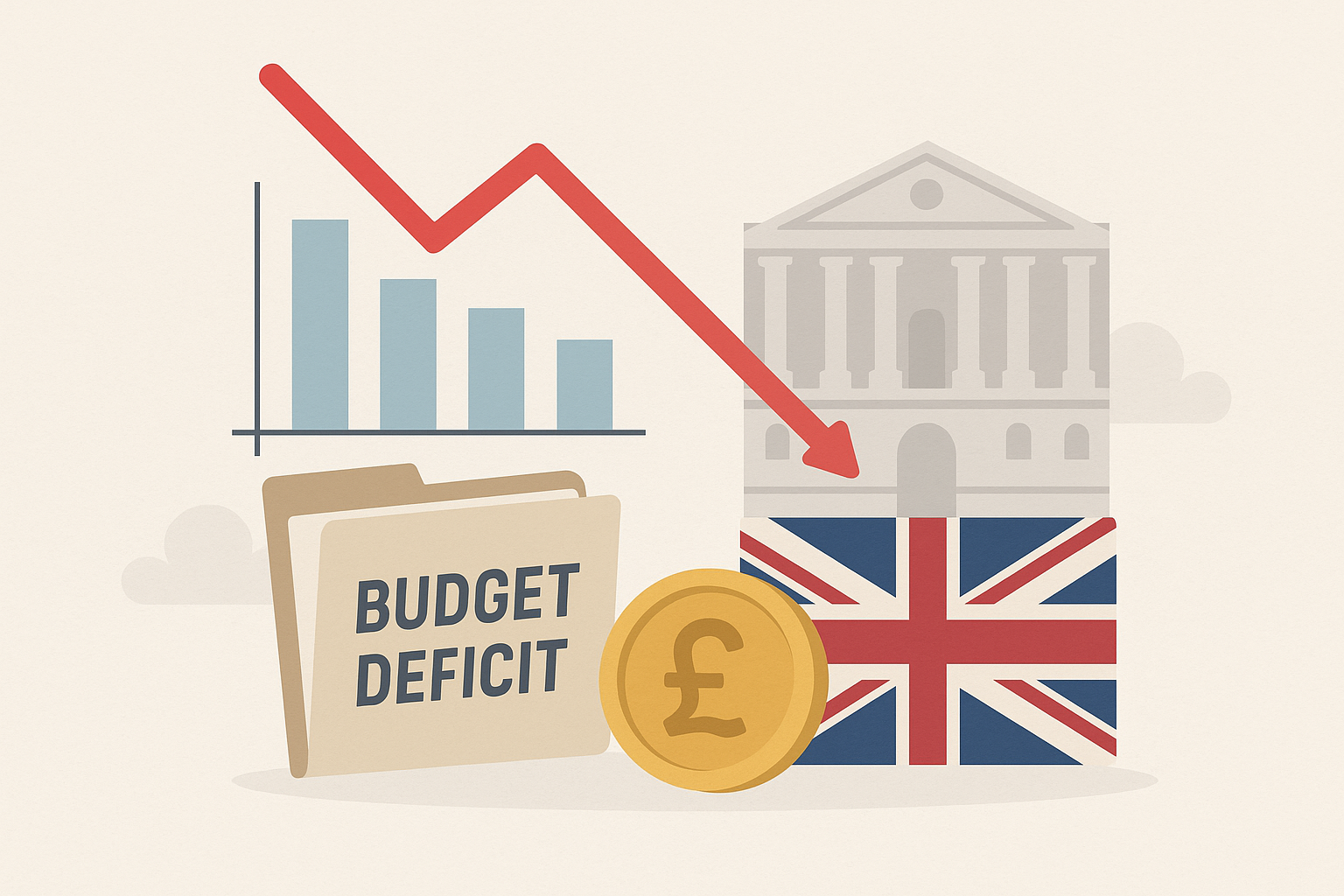Introduction
The British economy is facing a renewed wave of scrutiny as mounting budgetary imbalances begin to ripple through the currency markets. As of mid-June 2025, the British Pound (GBP) has shown notable weakness in global forex trading. Analysts and investors are pointing toward one dominant theme: the United Kingdom’s growing budget shortfall. With government spending expanding and tax revenues lagging, the public deficit has widened sharply. This fiscal development has raised red flags not only in bond markets but also among forex traders, who are closely watching the Bank of England’s (BoE) next interest rate decision amid this intensifying macroeconomic backdrop.
The Fiscal Picture: A Deficit Deepens
The UK government’s latest fiscal reports show a sharp increase in borrowing to cover public expenditures. Spending has accelerated across multiple sectors including healthcare, defense, and energy subsidies, while tax receipts have failed to keep pace. Analysts estimate that the UK’s budget deficit is now projected to exceed 6.2% of GDP for the 2025 fiscal year, well above the government’s own forecasts released in late 2024.
Several factors are driving this gap. First, the government’s continued subsidy programs to offset energy price shocks have extended longer than expected. Second, the economic slowdown that began in late 2024 has reduced corporate profits and household income, leading to weaker tax collection across the board. Meanwhile, inflation remains above the BoE’s 2% target, creating additional tension between monetary and fiscal authorities.
The Office for Budget Responsibility (OBR) recently published revised projections indicating a need for increased borrowing of over £80 billion to maintain current spending commitments. This level of deficit financing is contributing to rising gilt yields and undermining market confidence in the UK’s fiscal sustainability.
Currency Traders React To Fiscal Strain
In the forex market, the reaction has been swift. The British Pound has depreciated against major currencies including the US Dollar and Euro. GBP/USD, for example, dropped from 1.28 to below 1.25 in just five trading sessions. Investors are increasingly pricing in the risk that the UK’s fiscal position will limit the BoE’s ability to continue its inflation-fighting strategy through rate hikes.
This decline in the pound has been accompanied by increased volatility. Currency traders often view fiscal discipline as a pillar of monetary policy credibility. When a country shows signs of losing control over its budget, traders may reassess the long-term value of its currency. That’s exactly what seems to be unfolding in the UK’s case.
Currency analysts at major investment banks have highlighted the fiscal slippage as a key driver of Sterling’s weakness. A report from Barclays notes that “fiscal deterioration is directly undermining BoE’s monetary toolkit by challenging the sustainability of tighter policy.” HSBC’s FX team echoed this view, noting that “without credible fiscal reform or revenue growth, GBP remains exposed to downside risk.”
The Bank Of England’s Dilemma
For the Bank of England, the growing budget deficit introduces an uncomfortable dilemma. The central bank’s primary mandate is to maintain price stability, and inflation in the UK remains stubbornly above target. However, continuing to raise interest rates could place even more strain on the government’s finances, as higher borrowing costs make public debt more expensive to service.
This tension between fiscal expansion and monetary tightening is not new, but it is reaching a critical point. Economists argue that the BoE is now caught between combating inflation and avoiding a sovereign credit downgrade or market dislocation triggered by ballooning deficits.
The upcoming rate decision in July 2025 is expected to be one of the most contentious in recent years. Market expectations are currently split. Some analysts believe the BoE may pause its rate hikes temporarily to assess fiscal stability, while others argue that a token hike is necessary to preserve monetary credibility even in the face of political and fiscal headwinds.
Governor Andrew Bailey has remained cautious in recent public statements, acknowledging both the risks of persistent inflation and the limitations posed by fiscal developments. “Our monetary policy must continue to address inflationary pressures, but we cannot ignore the broader macroeconomic environment,” he noted in a recent testimony before Parliament.
Investor Sentiment And Bond Market Response
Investor sentiment has been noticeably shaken. UK government bonds, known as gilts, have seen increased selling pressure, pushing yields higher. The 10-year gilt yield has risen to over 4.5%, its highest level since the mini-budget crisis of 2022. Credit rating agencies have not issued formal downgrades, but Fitch and S&P have revised their UK outlooks to “negative,” citing concerns over fiscal governance and rising debt levels.
This has significant implications for forex markets. As bond yields rise due to fiscal risks rather than strong economic growth, it tends to signal increased sovereign credit risk. In such environments, currencies often face selling pressure, especially when investors see more stable alternatives in other developed markets.
Capital flight from UK financial assets could exacerbate the pound’s decline. Hedge funds and institutional investors have reportedly begun rotating out of UK-denominated assets in favor of US Treasuries and German Bunds, further eroding support for Sterling.
The Global Context: Why Fiscal Discipline Matters For FX?
Globally, the importance of fiscal credibility has only grown in recent years. With debt levels elevated in many advanced economies following the pandemic, currency markets have become more sensitive to budgetary trends. Countries that show signs of fiscal mismanagement often face a combination of currency depreciation, capital outflows, and pressure on central bank autonomy.
In the UK’s case, the combination of a high fiscal deficit, persistent inflation, and fragile economic growth forms a particularly toxic mix. Currency traders are not just reacting to numbers—they are evaluating long-term risks about whether the UK government will be able to restore fiscal discipline without undermining economic growth or triggering a broader market crisis.
The contrast with the United States is also instructive. While the US fiscal deficit is large in absolute terms, the Dollar remains the world’s reserve currency, giving it greater tolerance from markets. The UK, by contrast, lacks this structural advantage, making its currency more sensitive to any erosion in fiscal trust.
Political Dynamics And Policy Expectations
The UK government, led by Prime Minister Emma Reynolds, is under growing pressure to present a credible fiscal roadmap. The Chancellor of the Exchequer, Jonathan Whitaker, has hinted at potential spending cuts and revenue-enhancing measures in the upcoming Autumn Statement. However, with national elections due in 2026, there is political resistance to austerity, and any moves to tighten fiscal policy may face significant opposition.
This political uncertainty is another factor weighing on Sterling. Investors need policy clarity and credible timelines. Without them, the risk premium embedded in GBP assets will continue to rise. Some analysts have called for an independent fiscal watchdog with expanded powers to enforce medium-term budget targets and restore investor confidence.
Long-Term Risks For The Pound
The long-term outlook for the British Pound will depend on how quickly and effectively the UK can restore fiscal discipline. If budgetary trends continue to deteriorate, the BoE may find itself constrained in setting policy, even in the face of rising inflation or external shocks.
One potential long-term risk is the erosion of the UK’s safe-haven status. Historically, the UK has benefited from a reputation for stable institutions and sound policy. That reputation is now at risk. Should investors begin to view the UK as fiscally unstable, Sterling could lose further ground not only against the Dollar and Euro, but also against emerging market currencies seen as fiscally conservative.
Another concern is that the weakening of the pound could fuel imported inflation, creating a vicious cycle. A lower exchange rate raises the price of imports, especially energy and food, which in turn may force the BoE to keep rates higher for longer—further stressing the economy and public finances.
Market Forecasts And Expert Views
Market consensus for GBP remains bearish in the short term. Most major banks have lowered their GBP/USD targets for Q3 2025. JPMorgan, for instance, now forecasts GBP/USD at 1.22 by September, down from its earlier projection of 1.28. Morgan Stanley is even more pessimistic, suggesting Sterling could fall below 1.20 if fiscal concerns escalate further.
Currency strategists are urging caution and recommending hedges against Sterling exposure. At the same time, some contrarian investors see opportunity, arguing that much of the bad news may already be priced in. However, this view is not yet widespread.
Economic think tanks such as the National Institute of Economic and Social Research (NIESR) have also weighed in, suggesting that without immediate action to rein in the deficit, the UK risks a slow-burn credibility crisis that could limit its ability to attract foreign investment.
Conclusion
The events of June 2025 may mark a turning point for UK economic policy. The widening budget deficit, mounting market anxiety, and the Bank of England’s constrained maneuvering room paint a complex picture of fiscal and monetary tension. The British Pound is already reacting to these developments, and unless credible policy steps are announced, further currency weakness is likely.
Restoring fiscal credibility will be crucial—not only for preserving the value of the pound but for maintaining the broader macroeconomic stability the UK has long relied on. Investors, rating agencies, and central bankers are all watching closely. The question now is whether the UK government and the BoE can coordinate an effective response in time to prevent a deeper loss of market confidence.


